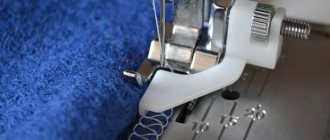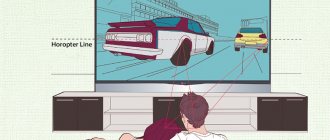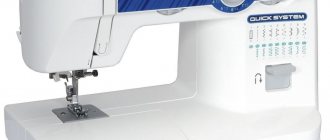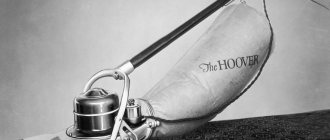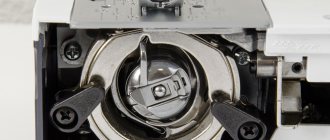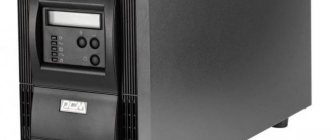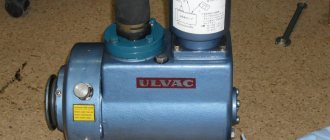What is overlock?
What is an overlocker and what is it for? Overlock refers to the types of sewing machines that are used to overcast sections of any textile materials. This process prevents the stitching of the material from unraveling and gives them a graceful appearance. Wrapping is accompanied by cutting off excess fabric, and some overlockers have a function for stitching product parts, which involves stitching a chain seam. They can perform different types of stitches:
- Classic.
- Decorative.
Overlock image.
Overlock functions
Although the functionality of the device is not great, it is indispensable for factory or high-quality home sewing. Later in the article we will consider the question: “Do you need an overlock for home sewing?”, and now let’s move on to considering its capabilities:
- Processing the loose edge is the main function for which you should take a closer look at this machine, because it is equipped with a knife and a looper (instead of a shuttle), which can simultaneously trim the crumbling edge and give it an aesthetic appearance.
- Sewing parts - in simple words, sewing two parts together; this point is relevant for models with the ability to turn off the knife.
- Giving a beautiful look - in our time, it is important that any clothing looks beautiful and aesthetically pleasing not only on the outside, but also on the inside: who would like protruding threads or crooked seams? It is the overlock that ensures the proper appearance of the wrong side of the product!
Sewing machine and overlocker
Types of classic seams
You can process the edge of the product using a regular sewing machine, but seams made with an overlocker are much more aesthetically pleasing and of higher quality. It provides for the implementation of 2, 3, 4, 5 thread stitches.
From two threads
Double thread threads are designed for very thin fabrics where you need to use a minimum number of threads. Since overlockers most often require the use of 3 threads per stitch, you need to make sure that this model has a converter. It looks like a special clip that covers the upper looper. To make a 2-thread seam, one needle and one lower looper are sufficient. The needle makes stitches from above, the lower looper is parallel to the bottom, and the upper looper connects 2 lines using a thread spiral. It can be used for fabric with any structure.
Image of a 2-thread stitch.
From three threads
The three-thread stitch is the most common and is performed both on a modern overlocker and on an old one. These are the most economical machines, since if 3 threads are enough for a future product, you can significantly reduce sewing costs. The stitching is done using simple technology.
Image of a 3-thread stitch.
From four threads
Using a four-thread stitch makes it possible not only to overcast the edges, but also to stitch together pieces of fabric. It is most suitable for stitching knitted items. To sew a knitted seam, two needles and two loopers are used. It can be used to process elastic fabrics.
Image of a 4-thread stitch.
Of five threads
Five-thread stitches on modern overlockers are performed with three needles. It can also be done on a carpet stitcher, which has a special lower looper for making chain stitches. It is best used for capricious fabrics, especially where a zipper or a large brooch is provided.
Image of a 5-thread stitch.
What threads are used for machine piecing?
Since the 3-thread rolled seam is naturally more frequent, it requires thinner threads. That is why textured threads (“gossamer”) are often used to perform it. Less commonly used are synthetics, for example reinforced threads such as linen-lavsan (LL).
Natural sewing materials are, as a rule, not used when processing fabric with a machine rolled seam. The fact is that due to the frequent stitching and its complexity (compared to conventional machine stitching), there is a high probability that the threads will break. And synthetics are much stronger in this regard.
Another aspect why natural threads are not used for opiating is their diameter. They are generally thicker than synthetic ones. For this reason, they have to use a more massive needle, which is unacceptable when processing thin, elegant fabrics. Thus, the rolled seam itself will look unpresentable. But it is more often used specifically for decoration.
However, if a rolled seam is made by hand, needlewomen themselves can choose which threads to use. Indeed, in this case everything depends on the skill of the seamstress herself.
Types of decorative stitches
Modern models of overlockers provide great opportunities for making unique products thanks to several types of seams. These include:
- Role-playing.
- Flat.
- Double sided.
Role-playing
Rolled seam on an overlocker - what is it? In some sources it may be called roller or opiss. To obtain it, manipulations are carried out in which the tensioner in the overlock machine is adjusted. The final result of the finished edge appears to be curled inward. This makes it possible to create a wavy frill. And inserting fishing line into the edge of the skirt will make it elastic. If you use this maneuver to overcast the petticoat, you can get a fuller hem. The rolled seam not only processes the edge of the fabric, but also sews the frills of the suit. This hem is often used when sewing dance costumes. This seam fits harmoniously on decorated parts of tulle and knitwear.
Image of a rolled seam.
A roller seam is performed by reducing the stitch length to a minimum and changing the stitch width. All overlockers have a special tongue located near the needle plate. During sewing, it is positioned so that it is surrounded by the top loop on one side and the fabric on the other. Thanks to this, the edges of the fabric do not curl and the stitching is done in the same width. To obtain a roller stitch, simply remove this tongue. Then you will get a line with a minimum width (about 2 mm), and the edges of the fabric will be curled inward.
Flat
Real flat stitching is done not with an overlocker, but with a cover stitching machine. This is a completely different type of sewing stitch, which is formed differently from the overcast stitch. Some types of overlock machines have a flatlock function. It makes it possible to obtain only a stitch that is visually similar to a flat seam. You can make a real cover seam using carpet lockers. However, the price of such machines is much higher than others, so not everyone can buy them. In this case, you can use an imitation of a flat stitch on an overlock machine.
Image of a flat seam.
The flat type is a decorative function, useful in the process of designing the hem of the lower part and sleeves of the product. It is also suitable for processing cuts on thin fabrics, stitching knitted parts and trimming excess. To perform a stitch, you need to have a special foot designed for this work. Some models come with it right away, while others require a separate purchase. A flatlock seam on an overlocker can be done with two or three threads. Each machine has different capabilities. Stitch parameters may also differ. If the connection is made with the right needle, then the stitch will be narrow, and if with the left, it will be wide.
Flatlock image.
Bilateral
Double-sided seams (also called flat top stitches) can only be made using modernized equipment that allows you to use a large number of threads at once. Threaded threads are intertwined in quantities of 5 to 10 pieces, and thanks to the resulting beautiful stitches, products with beautiful prints are created. Double-sided stitches are not intended for edge stitching; they are used to create decorations for clothing.
Since the overlocker has many capabilities and processes overcast stitches with high quality, in addition to the sewing machine, it is recommended to purchase an additional overlocking device.
Image of a double-sided seam.
The difference between an overlocker and other machines
On the sewing equipment market you can find a wide variety of machines for knitwear and stretch fabrics, the most popular of which are: overlock, coverlock and cover stitcher.
Each of them is good in its own way, and is used for certain (highly specialized) tasks; in the table below we show the main differences of each type:
The difference between an overlocker and other machines
These machines are united by the presence of a looper, which replaces the shuttle (which is found in any household machine), but the specialization is still different. We wrote more about the carpet locker and the cover stitching machine in separate articles.
Tips for choosing seams
The overlock machine has all the capabilities to carry out work that allows maximum maneuverability when creating overcast stitches. When choosing a machine and stitch, keep the following in mind:
- If you buy an overlocker only to overcast edges, then you can limit yourself to a machine that allows you to work with two or three threads. And if you plan to make products with decorative stitches, then it is better to purchase an overlocker with a four-thread overlock.
- The presence of a differential feed option makes it possible to process elastic fabrics and produce assembly elements or flounces.
- Due to the fact that the width of the cut is adjustable, it is possible to make one seam in different versions.
Thanks to the variety of stitches produced by overlocking machines, you can implement any sewing idea and achieve a good result in your design solution. The main thing in this matter is to have a high-quality overlocker that satisfies all the needs of the seamstress.
You can also find out which sewing machines are considered the best.
Sewing machine with built-in overlocker
The sewing equipment market does not stand still; large companies offer for sale sewing machines with a built-in overlocker. Is it worth buying them and what's the catch?
Can such a machine COMPLETELY replace an overlocker - of course not, BUT it is more than suitable for home sewing for your family.
Below we show an imitation overlock stitch and a real overlock stitch:
Imitation and real overlock stitch
The quality of the emitting seams depends on the cost of the model, but you should not expect a 100% replacement of the original.
Five-thread seam
The five-thread stitch is called the classic overlock stitch. Most often it is used to process denim pants, therefore, by turning such a product outward, you can become familiar with the principle of processing this type of seams in detail.
A five-thread rolled seam combines three- and two-thread seams at the same time, between which a “chain” of overcasting passes at a selected distance.
Sewing is carried out using two needles and three loopers, one of which is presented in the form of a chain stitch lever.
With the help of such stitches, crumbling types of fabrics are most often processed.
The main feature is the simultaneous performance of two functions: hemming and overcasting the edges of the material.
Overlocker models, which were among the latest to enter the market, can perform operations by working with ten threads simultaneously. In this way, products are finished with decorative seams. Intertwined threads form various patterns, shapes and ornaments that give the products a special touch.
Basic setup rules
The principle of regulation does not depend on whether your overlocker is Taiwanese, Japanese or Chinese, since their thread tension regulators are located on the outside of the machine body. As a rule, there are 4 of them, according to the number of threads involved in the stitching process. All regulators have a tension scale from 0 to 9.
For each type of fabric, you need to set up an overlocker before starting work.
The regulator values are set depending on the thickness of the fabric and the type of thread used. In most cases, stitching can be done at the tension setting set to “4”.
But you shouldn’t immediately start processing the product itself. First check the quality of the overlock seam on a piece of fabric and, if the process went well, you can start working.
The degree of thread tension is regulated as follows:
- from 2 to 3 – weak tension;
- from 3 to 5 – average tension force;
- from 5 to 7 – strong tension.
An important condition for high-quality stitching of the material is the thickness of the thread, and it is important that all 4 threads are of the same type and thickness. Another condition for obtaining an even overlock stitch will be the correct selection of the needle thickness number corresponding to the density of the fabric being processed. Typically, for each overlocker, in the operating instructions, the manufacturer indicates the brand of needles and their recommended numbers.
If the needle is not the correct size and thickness, it can cause the stitching process to fail and, in some cases, even cause the machine to break down.
Thread tension
Each tension regulator performs its own function; on the overlocker they are painted a certain color. Their function is as follows:
- the first regulator is responsible for the thread tension of the left needle of the machine;
- the second regulator is responsible for the tension of the right needle thread;
- the third regulator – tensions the upper looper thread;
- the fourth regulator tensions the lower looper thread.
When setting up, we use a piece of fabric as a test sample and carefully examine the quality of the stitching. We carry out inspection and necessary adjustments in the following sequence.
- Checking the operation of the left needle. If we see wrinkles on the fabric, it means that the thread tension is too high. Therefore, we reduce the regulator value by one division and again check on a fabric sample how the stitching will look. We reduce the tension until the wrinkles on the processed section disappear.
- Checking the evenness of the stitching. The left needle is also responsible for this. If we see a “ladder” of threads, it means the tension needs to be increased a little.
- Once we have found the desired indicator for the left needle, which produces an even stitch without wrinkling the fabric or loosening the threads, we set the same value for the right overlock needle.
- We evaluate the work of loopers. The stitching on the fabric should be even, the pattern between the stitches should be uniform. If you see loops of threads behind the edge of the cut of the fabric being processed, it means that the tension of the looper threads is too weak - it needs to be increased. The adjustment is carried out until the threads for which the loopers are responsible lie flat.
Three-strand seam
This type of seam is considered the most basic. If you do not plan to work in the clothing industry in the future, you may well limit yourself to using a three-thread rolled seam for processing products. To perform it, you will need a needle and a pair of loopers - levers with special holes into which the threads are threaded. Using this device, the thread is fed over the fabric.
In fact, if you sew for yourself, you don't have to buy a serger. Today you can purchase several sets of presser feet, including overlocking ones, and sew for your own pleasure the same beautiful things as from the factory. Sometimes something you sew yourself turns out to be of better quality than goods from a store, and if you are a master of your craft and know how to cut, then it is much cheaper.
Using a three-thread seam, sections in products made from different types of fabrics are processed.
Let's sum it up
- Today, the simplest models of overlockers are produced in the following combinations: three + four-thread overcasting, or two + three-thread overlocking.
- Using an overlocker only for the purpose of overcasting cuts, a machine with a three-thread overlock stitch is quite suitable.
- Using an overlocker only for the purpose of overcasting cuts, a machine with a three-thread overlock stitch is quite suitable.
- A four-thread seam is formed in a two- or three-needle overlocker.
- Only on a carpet stitch (and you also need to have a chain stitch looper) can you make a five-thread overlock stitch.
- Flat cover seams are also made only on carpet.
- A three-thread Flatlock stitch can be produced using any overlocker. A two-thread Flatlock stitch is created using a two-thread overlock.
- By removing the special tab in the overlocker (if possible), you can get a rolled overstitch.
- Using the differential feed mechanism, you can protect elastic fabric from stretching, as well as create gathers and ruffles.
- Additional, but not required, are functions such as trimming width adjustments, easy looper threading, a sleeve platform, etc.
Having in your arsenal the necessary stock of knowledge regarding overlockers, you can safely go to a specialized store and there, comparing the prices of machines, analyzing the functionality of overlockers, checking their quality, purchase the very model that interests and suits you personally.
Additional functionality
The useful functions of the overlocker described above do not end there. In addition to the basic ones, the device can be equipped with additional devices to expand the functionality, for example, paws and feet designed for cutting threads and working with decorative elements. You can purchase a sleeve platform for high-quality sewing of product parts. As you can see, the rolled seam, the photos and features of which we studied, is not the only thing that can be done using this machine.
Having a certain amount of knowledge about overlockers, as well as having decided on the direction in sewing, you can safely go to monitor market offers. By analyzing the prices, functionality and quality of the machines, you can choose exactly the model of the mechanism that you need.
Four-thread stitch
An improved analogue of a seam consisting of three threads is a four-thread overlock. When processing products using this principle, needles (2) and lower loopers are used during the work process. Externally, three- and four-thread seams are similar, the only difference is the additional stitching that complements the second one.
The peculiarity is thinness and strength at the same time. Therefore, a rolled seam, consisting of four threads, is best suited for joining parts of products and at the same time overcasting them.
Do you need this product?
The purchase of any household appliances must be motivated. If you are interested in home sewing or are planning to master it, then an overlocker will be a useful addition to creating high-quality exclusive outfits for the whole family. With overlock, both the front and back sides of the product will look neat and aesthetically pleasing.
This sewing machine can also be a wonderful gift for friends or relatives who sew at home. Overlocking with an overlocker becomes a pleasant and quick process that does not require eye strain and a lot of time. That is, this household appliance, as befits equipment created for the home, makes the housewife’s work easier.
Features of work
It is incorrect to ask the question about what an overlock is in a sewing machine. She creates an imitation using a simple zigzag stitch. When tensioned, the threads may break. The result is poor quality processing. This is the main reason to purchase a machining machine. But if this is not possible, it is recommended to know the features of working on a machine with such a stitch.
A novice seamstress should know that it is worth processing the edges of products using a foot for these purposes. Each type of stitch is suitable for different purposes. For bed linen, for example, oblique imitation should be used.
Sewing machine with overlock stitch
The subtleties of obtaining a quality stitch
There is an optimal way to set up an overlocker before work. To do this, you will need a piece of test fabric on which to check the quality of the seam. Pass the workpiece through the machine and carefully inspect the resulting stitch.
- The inspection begins with the loop of the left needle. Wrinkled fabric means excessive tension on the needle thread. Loosen it by gradually changing the value on the regulator. After each single change, pass a piece of fabric through the machine, repeat the procedure until the material stops creasing.
- The next stage includes checking the seam for evenness. When the fabric has stopped wrinkling, you can proceed to the next procedure - take the fabric so that the seam is in the middle. Pull the ends in different directions and take a closer look. If instead of tightly fitting halves you see a ladder of threads, you need to increase the thread tension. The procedure, like the previous one, is carried out step by step. Don't rush, setting up a sewing machine is a painstaking task. Pay special attention to the left needle thread, it is what connects the loops to each other. The quality of the stitching depends on the correct tension. Having identified the optimal value for the left thread, set exactly the same for the right one. This rule is relevant for all types of fabrics; the ratio between the right and left threads never changes.
- The final stage is to determine the location of the interlacing of the looper threads - it should be on the outermost section of the piece of fabric. In this case, the seam is laid in an even line, forming a flat pattern between the stitches. Loops protruding beyond the edge of the fabric indicate weak looper thread tension. Pull them a little and test them on a new piece of material. If the loops of one looper creep over the edge, then only its thread needs to be tightened. Watch this carefully, because if you choose incorrectly, you risk creating excessive tension and causing weave on only one side of the fabric. In this case, you will have to loosen the thread step by step until the buttonhole stitch returns to normal. In some cases, it is necessary to simultaneously tighten one looper and loosen another. Experts recommend starting with weakening.
Overlock looper
By setting up the overlocker according to the above diagram, you can avoid many problems. The instructions allow you to adjust the settings to any type of fabric and successfully perform work of any complexity.
